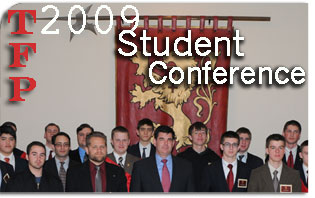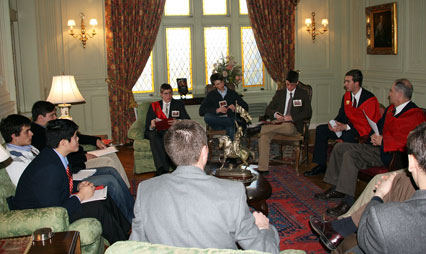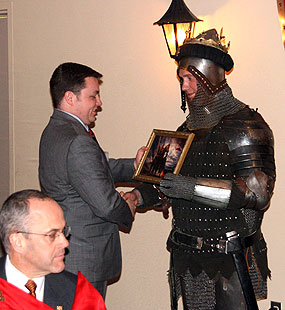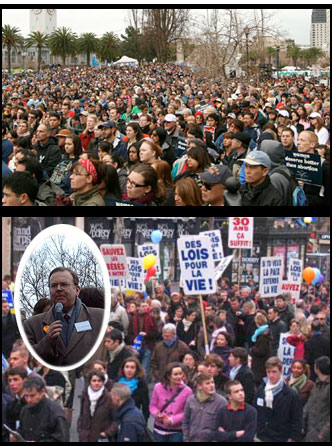Answering the above question is extremely important, since it is a Communist tactic to immobilize their adversaries by calling them Nazis or Fascists.
BENITO MUSSOLINI, THE ITLIAN FASCIST LEADER.
We will prove that one who is truly against Communism, must also be against Fascism, for the two ideologies are similar. Likewise, one who is truly against Fascism must also be against Communism for the same reason.
Someone could object that if this is the case, then Communists should call themselves Fascists. We answer that, in the rigor of logic, they should be synonymous for Fascism and Communism are similar, not only in their secondary aspects but also in their essential aspects. This is precisely what we are going to prove.
I. Philosophical Concepts
We have lined up statements from the principal mentors of Nazi-Fascism with statements from the most important ideologies of Communism. The resemblance between the two is patent.
NAZI-FACISM
COMMUNISM
They obey common ideologists:
Marx and Hegel.
"The National Socialist movement has one single master: Marxism." - Goebbels1
"Mussolini likes to affirm that Marx is his spiritual father."2
Croce and Gentile, the ideological mentors of Fascism, resort to Hegel in the elaboration of Fascism.
"We are Communists, disciples of Marx and Engels."7
The Marxist affiliation of Communism is evident.
Marx for his part drew his dialectics from Hegel.
Both have an atheistic doctrine.
"We want no other god than Germany" - Hitler3
"God is the personal enemy of the Communist society." - Lenin8
Both have a dialectical doctrine.
"Struggle is the origin of all things, because life is full of contrast." - Mussolini4
"The law of contradiction, which is inherent to all things, to all phenomena, is the fundamental law of dialectical materialism." - Mao Tse Tung9
Both have an evolutionist doctrine.
"We know that there is no definitive state, that there is nothing durable, that there is only a perpetual revolution." - Rauschning5
"There is nothing definitive, absolute, or sacred. The only thing that exists is the uninterrupted process of the future and the transitory." - Engels
Both have a revolutionary doctrine.
"The program of the conception of the world has the sense of a declaration of war against the order of things which exist, against the state of things which exist, in a word, against the structure of the world which presently exists." - Hitler6
"Everything which exists must die." - Engels.
1Goebbels, Kampf um Berlin, page 19.
2Mussolini y el Fascismo," in Que sais je. (in Spanish), page 31.
3Bayrischer Kurier, May 25, 1923.
4Mussolini, "Le Fascisme," in Discursos al Politeoma Rosetti de Trieste, 9-20-1920, Ed. Denoel et Steele, Paris.
5Rauschning, Hitler Said to Me, 1937.
6Hitler, Mein Kampf, page 508.
7Thorez, M., Discurso del 28 de Octubre de 1937. Ed. Comite Popular de Propaganda.
8Ousset, J., "Carta a Gorki (dicembre de 1913)" in Le Marxisme-Leninisme, page 132.
9Mao, On the Question of Contradictions.
II. Concept of the State
NAZI-FACISM
COMMUNISM
Both are heralds of a totalitarian state.
"Everything in the State, nothing against the State, nothing outside the State."- Mussolini1
"The State is the continent and the race is the content." - Hitler2
"The dictatorship of the proletariat (the name given to the State) is domination unrestrained by the law and based upon force." - Lenin3
The State absorbs the family and property.
1Mussolini, "A la Camara de Diputados 9 de diciembre de 1928" in Discursos de 1928, page 333.
2Hitler, Mein Kampf.
III. Economic Concept
NAZI-FACISM
COMMUNISM
They promote socialism.
"We are socialists and mortal enemies of the present capitalist economic system."1
"It is evident that Communism fights for the destruction of the capitalist system and the implantation of socialism."
They promote the abolition of property.
"Socialism is the concept of the world of the future which can only be realized in the socialist state." -Goebbels2
"We can sum up our doctrine in this proposition: the abolition of private property." - Marx and Engels3
Where the right of private property does not exist there is no justice. Socialism distributes only misery.
1Der Nationalsozialismos, die Weltanschauung des 20. Jahrhunderts.
* Capitalism in as much as it is based on private property and free enterprise is not in itself condemnable. But its abuses are condemnable.
2 Goebbels, Die Zweite Revolution.
3 Marx and Engels, The Communist Manifesto.
IV. Methods of Action
A cult of violence.
Nazi-Fascism and Communism both promote a veritable cult of violence; the brutality of their methods has become legendary. It could not be any other way: Nietzche (for the Nazi-Fascists) and Lenin or Mao (for the Communists) did not going to allow themselves to be held back by the "bourgeois prejudices" of a morality. Accordingly, with neither God nor law, they were prepared to sacrifice all things in the interests of their nefarious ends.
V. Concept of the Family
NAZI-FACISM
COMMUNISM
Children are torn away from their families.
"The children are educated in common by experienced educators in special nurseries. The youths from the time they reach six years of age, in boarding school for boys. The "reproductive" mother lives supported by the "House of Maternity." - Dr. Dupre1
"They reproach us with wanting to abolish the exploitation of children by their parents. Well then, we confess that crime." - Marx and Engels3
The dissolution of the family.
"Monogamy for the whole of life is anti-natural, and a degradation of the species." - Dr. Bergman2
"Positive propositions in view of a future society...
Abolition of the family, of private gains..." - Marx and Engels4
Without the family there is no morality.
1Weltanschaung and Rassenzuechtung.
2Erkenntnisgeist and Muttergeist.
3Marx and Engels, Communist Manifesto.
4Marx and Engels, Socialismos utopicos y Socialismo Screhtifico. Ed. Socialis, Paris.
The comparative tables above show clearly the similarities between Communism and Nazi-Fascism. Both systems, being inspired by the aberrations of Karl Marx, have as a consequence an erroneous dialectical and evolutionist interpretation of society. Their doctrines are fundamentally similar, having atheism and materialism as their basic postulates.
From these postulates, they deduce a socialist socio-politico-economic system, which, annihilating all of the organisms that should exist in a society (the family, unions, etc.); raises upon its ruins the omnipotence of the state, in one case called the dictatorship of the proletariat and in the other, the Third Reich. Everything is sacrificed to that Moloch; individual rights disappear; parents are even deprived of their rights over their children.
The work of the Nazis; in tearing father from son, and mother from daughter, is also done by Communism. It is the same abomination which presents itself under different labels, two faces of the same coin. The reasons that lead a person to oppose Communism must lead him also to oppose Nazi-Fascism, because everything that is abhorrent and anti-natural in the one is to be found in the other. They are sons of the same father, Marx, and have the same end: the destruction of civilization.
Someone could object by pointing to the conflicts in word and deed that occurred between the Nazi-Fascists and the Communists. Such an objection is easily answered by analyzing the nature of these disputes, which have very little about them of real conflict and very much that is operetta.
Even a partially informed observer perceives the deceit, for there has been no struggle between Nazi-Fascism and Communism, but between Nazi-Fascists and Communists who engage in fights and disputes that do not challenge their common doctrines and methods.
These "conflicts" have been skirmishes between "brothers," bypassing that which is most essential - their doctrine. They even provide mutual support for each other, since in that incautious person, believing in a real opposition in the two ideologies, joins one in order to combat the other.
Thus, credulous persons who were crystallized against the aberrations of the Nazis joined the Communists, and others crystallized against the Communists joined the Nazis. Accordingly, it can be seen that Communism and Nazi-Fascism are two sides of the same pincer, two jaws of the same beast.
But if anyone doubts that the Communists are being cynical who to call their true adversaries "Fascists," we ask them to meditate on this sentence of the masters of Communism: "For the revolutionary, everything that contributes to the rebellion is moral and everything that impedes it is immoral and criminal." (Marx and Engels, Obras, Berlin, 1962, Vol. 28, page 427).
How to Avoid Falling into the Traps of Communism
1. Have a clear knowledge of the Communist doctrine, its ends and methods, in order to able to combat it with efficiency, without falling into a false anti-communism, such as Nazism or Fascism.
2. In order for the action to be complete, know the principles and final ends of anti-communism, because no one fights for an ideal that he does not know.
3. We ought to have a love for the cause that gives us heart, abnegation, and willingness to sacrifice for the combat, because without this, however true our ideals may be, we shall never conquer.

















































